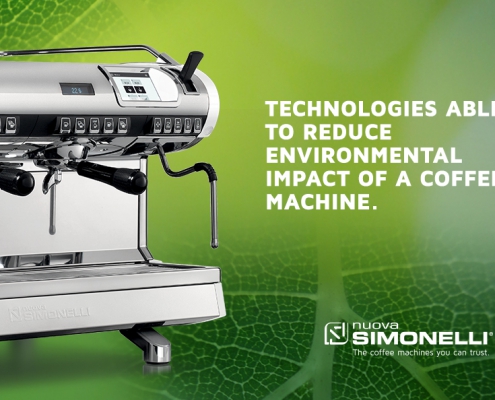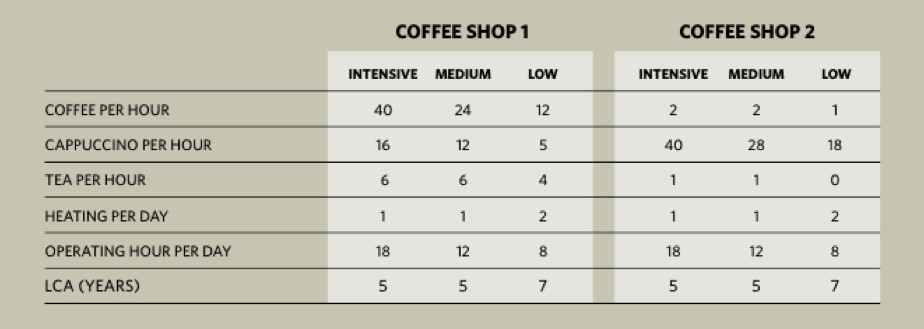
The Nuova Simonelli path starting from the LCA calculation of environmental impact to the technologies able to reduce energy and waste.
What is the environmental impact of an espresso coffee machine? And how do technologies of the espresso coffee machine reduce the ecological imprint? It has been seven years that Simonelli Group Engineering team, along with the researchers of the Polytechnical University of Le Marche Design Tools & Methods department and the Cluster Marche Manufacturing*, put on board these issues to create not only high performant coffee machines, but also seek to make them as environmentally sustainable as possible.
How is the environmental impact of a coffee machine measured?
The most used tool is the Carbon Footprint that expresses in equivalent CO2 (CO2eq) the total greenhouse effect directly or indirectly on a product. To check the environmental impact of the coffee machine, the Life Cycle Assessment (LCA), a standard method (IS= 14040 and 14044), is applied. It verifies the influence a product, process, or service has on the environment throughout its life cycle, starting with the production, up until machine disposal. The LCA calculation is quite helpful as it accurately and immediately measures the footprint each product leaves in our ecosystem. This tool allows us to evaluate the environmental impact of an espresso coffee machine to establish solutions that can contain and maximize these values.
The LCA calculation results:
The LCA method determines the results adding all external factors such as the materials used (type, quantity, weight, etc.), the logistics of the components, the entire production phase, and the transportation methods of the final product in the worldwide market. This first group calculates the manufacturing impact; then, the consumer impact is added in, which includes all the energy consumed during the product’s life cycle, up until the machines “end of life” phase, where it is dismantled and recycled. In this last phase, the impact depends on the material; if it is a highly recyclable material, the dismantling of the product is nothing less than positive.
The manufacturing phase of a 2-group traditional coffee machine can have a value between 550 and 850 Kg of CO2 eq, which is equivalent to one person traveling by airplane from Sydney to Perth. During the dismantling phase, a maximum CO2 eq that can be recuperated is of 110 Kg. However, the consumer phase during the Carbon Footprint calculation of a coffee machine is the dominant one. It has a rate that can vary from 95% to 99% of the total CO2 eq production. A lot depends on the conditions of use and the intensity, which can mean the number of drinks brewed and the type of energy of the country in which it operates.
The consumer phase: the LCA calculation for the different styles of use.
To evaluate the environmental impact of the entire life cycle of an espresso coffee machine, the researches of the R&D department of Simonelli Group, together with the DT&M team, arranged two scenarios to base the calculation on the different consumer styles present on various markets. The first scenario has a protagonist, a coffee shop (Coffeeshop1), where there is a preponderance of coffee making, as seen in most Italian and European shops. The second situation has a cafè (Coffeeshop2), where milk-based drinks are a majority, found principally in the American market as well as in other markets. A medium life span of 5-7 years on the machine was speculated for both cases, while three different levels of consumer intensity of the devices where hypothesized, identified as intensive, medium, and low.

It was found that the environmental impact of Coffeeshop2 is averagely higher than 50% in confront to Coffeeshop1 (in all three level intensities). As seen in the graphic above, the manufacturing phase impact is minimal compared to the consumer phase impact. Higher the intensity of user activity, the lower is the manufacturing impact.
Technologies able to reduce the environmental impact of a machine during the consumer phase
The above analysis is the offset point of a project started eight years ago between Nuova Simonelli and DT&M, intending to find technologies able to reduce the CO2 emission of the production and consumer phase drastically while keeping and possibly increasing performance levels.
A challenging goal of which already gave satisfying results seen through the various technologies that strongly reduced energy consumption, while maintaining high-performant levels. The T3 technology of Aurelia Wave is an example. It guarantees maximum consistency of the result during the entire working day and saves energy (also less CO2 emissions) about 30 to 40% more compared to a machine with different technology. The EasyCream technology (present in Aurelia Wave and Appia Life) along with the ClimaPro technology of the Mythos 2 and Mythos 1 grinders, also contributed to the reduction of environmental impact. Thanks to a more precise and consistent dosing system, these technologies can all around reduce waste and energy. Just like in the Autopurge system of the Aurelia Wave, we can see a decrease in water waste because of the correct cleaning procedure of the machine.
It is this way that a wise project and advanced technologies contribute to creating a high-performant and sustainable machine.
*Cluster Marche Manufacturing, a public and private partnership composed of Universities, Research Institutions, and Companies that studies the needs and requirements of manufacturers, with the primary goal to promote efficient, automated processing that decreases environmental impact, keeping it human-oriented.